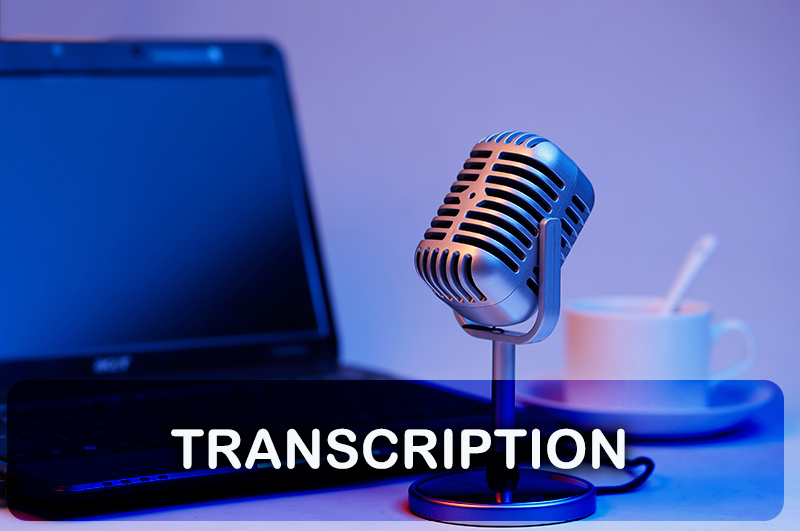Businesses often require transcription services to convert audio files of different activities and events into text for various purposes. Whether you are a researcher seeking to transcribe recorded interviews and surveys, or a lawyer needing to document court proceedings and depositions, accurate and timely transcription is essential. However, transcribing audio files can be laborious and time-consuming. Thankfully, there are options available today, including human audio transcription services and machine transcription, to simplify the task.
Human-generated transcription involves a human transcriber listening to an audio recording and manually typing out what they hear. On the other hand, in automated transcription, a machine automatically transcribes the audio content and generates the text without human intervention. The decision between human and automated transcription services depends on your specific requirements, budget, accuracy needs, and the nature of the audio content being transcribed.
Key Aspects of Human Transcription Services
In human transcription, a trained human transcriptionist converts the spoken words in recorded interviews, lectures, webinars, meetings, podcasts, etc., into written text. Human transcription involves various steps:
- Listening: The transcriptionist listens to the audio or video recording carefully, even multiple times, to transcribe the spoken content accurately.
- Typing: The transcriptionist types the spoken words into a text document, making necessary modifications based on your specific requirements or preferences. Verbatim transcription captures the audio content exactly as it is spoken, including every word, utterance, filler words, etc. Non-verbatim transcription, also known as edited or clean transcription, involves capturing the main content of the audio without including the unnecessary speech elements to produce a more polished transcript.
- Attention to context and relevance: General transcription companies have transcriptionists with good language skills and knowledge of specialized terminology used by legal and medical professionals. They can interpret accents, dialects, colloquialisms, slang, and cultural references and other nuances of the spoken content to provide an accurate and contextually relevant transcription.
- Review, editing and proofreading: To ensure accuracy, correct any errors, and improve readability, professional transcriptionists review, edit, and proofread the transcription. This includes verifying the spelling of names, researching unfamiliar terms, and ensuring proper punctuation and formatting.
- Speaker identification: If the recording has multiple speakers, the transcriptionist will identify the speakers using cues such as voice tone, speech patterns, or speaker labels, and attribute the spoken words to the apt speaker in the transcript.
- Formatting and time coding: The transcriptionist formats the transcription based on the client’s specific requirements, such as font style, font size, margins, and other formatting guidelines. Time coding may be done to align the transcribed text with the corresponding audio or video recordings, enabling easy reference and navigation. The process of creating synchronized transcripts involves adding time stamps or time markers to the transcript at regular intervals, indicating the start and end times of each segment of audio content.
- Quality checking: The final step is quality assurance. Before the transcription is delivered, it is carefully reviewed to ensure accuracy, consistency, and adherence to client needs.
Human transcription focuses on producing accurate and reliable transcription that meet the client’s specific requirements.
How Automated Transcription Works
Automated transcription uses artificial intelligence (AI) and machine learning technologies to automatically convert audio or video content into written text without human intervention. Automated transcription software comes with advanced algorithms that analyze the audio or video content and automatically generate a transcript by converting the spoken words into written text.
The process of automated transcription involves several steps, such as speech recognition, language processing, and text generation. The software analyzes the audio content, identifies speech patterns, and converts the speech into text. The generated transcript can then be edited, reviewed, and formatted as needed.
Today, there are advanced AI-powered software tools that transcribe live or recorded audio or videos into text quickly. These tools transcribe the content in real-time and can also be used to transcribe pre-recorded audio or video files. Similar to human transcriptionists, automated transcription software can handle various audio formats, including interviews, lectures, webinars, meetings, podcasts, and more.
TranscribeMe and Otter are two popular automated transcription technologies. TranscribeMe provides industry-specific transcriptions, translation, and data annotation services. PC Magazine describes TranscribeMe’s website as”streamlined and intuitive to use”. Otter.ai is a cost-effective option featuring a mobile app and Chrome extension. It supports major video conferencing platforms but is suitable only for low volume transcription.
Human Transcription or Machine Transcription – Which Should You Choose?
Both human transcription and machine transcription convert spoken language into written text, but they differ in several aspects. To choose between these options, there are several factors to consider:
- Accuracy: Audio transcription services provided by humans tend to come with higher accuracy levels compared to automated transcription. This is because human transcriptionists can better comprehend accents, dialects, and complex content. They can also interpret specialized terminology or jargon specific to a particular industry or field. On the other hand, transcription software may find it hard to decipher variations in speech patterns, background noise, accents, and specialized terminology or jargon, affecting transcription accuracy.
- Turnaround Time: One of the most important advantages of automated transcription over human transcription services is faster turnaround time. Transcription tools can convert audio files into text in real-time or with minimal delay. Human transcriptionists can take longer to transcribe lengthy and complex audio content.
- Customization: Human transcription can be customized to meet specific requirements or preferences, such as formatting, speaker identification, or verbatim vs. cleaned-up transcription. While software tools offer convenience, they may not be adjustable to specific needs or preferences.
- Audio quality: Human transcriptionists can produce accurate transcription even from poor quality audio files with background noise, low clarity and multiple speakers talking simultaneously. Audio quality can significantly affect the accuracy of machine transcription.
- Nature of the content: If you need to transcribe audio content that is sensitive or confidential in nature, human transcription services may be the better option. General transcription service providers have strict data security protocols in place to maintain the confidentiality of client information. Automated transcription may pose a higher risk of data breaches or privacy concerns.
- Cost: As automated transcription services do not involve labor-intensive manual work by skilled transcriptionists, they are usually more cost-effective than human transcription services. However, experienced transcription companies offer affordable services, making them a great choice for academic transcription.
Both human-based and machine-generated audio transcription services come with their own pros and cons. Ultimately, choosing between these options depends on your specific needs such as accuracy, speed, and budget. Keep in mind that even if you choose an automated solution, you would need to get your transcripts vetted for accuracy by an audio transcription company.
Make the smart choice for your audio transcription needs! Experience the convenience and reliability of our professional transcription services.
Call (800) 670-2809 to get started!




